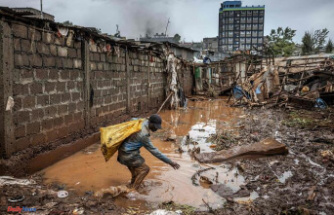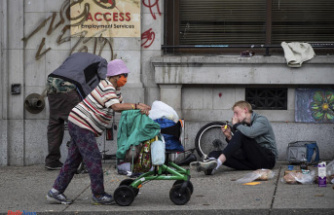"I have about fifty cows, but I will have to sell at least a third of them." This year, Bertrand Besson, milk producer in the Loire, has no choice: he is forced to reduce the number of animals on his farm to reduce his expenses. Faced with the current climatic vagaries, the people of Loire are far from being the only ones in this situation. A heat wave is expected this week, after three heat waves in June and July and a winter marked by a 40% rain deficit. Today, 93 departments out of 96 are subject to water restrictions to varying degrees. Météo France warns: by mid-August, "it is very likely that this soil drought will worsen further in a large number of regions".
For the producer, who says he has produced only a "small half in yield compared to usual", this climate will cause him to lose even more milk: "We will run out of food for the animals, especially fodder and corn." Grass production fell by 21% on July 20 compared to normal, according to data from Agreste, the statistical service of the Ministry of Agriculture. Result: breeders draw food from their stocks that they should not have touched before October. Hence the fear that in the fall, the cows will no longer have enough to eat and therefore can no longer produce. "If we had the cash for it, we would try to compensate by buying external food", regrets Bertrand Besson. But these means, the producer does not have them, despite the rise in dairy product prices in recent months. The price of yoghurts increased by 4.5% between June 2021 and June 2022, butter by 9.8%, cheese by 5.2% and semi-skimmed milk in cartons or bottles by 4.5%. Consequence on the shelves: there will be fewer bricks and they will be more expensive, to the chagrin of consumers.
"When charges increase, isn't it normal for prices to increase?"
The price of milk paid to producers rose to 427 euros in May 2022, an increase of 37 euros in one year. An increase still insufficient, according to the president of the FNSEA, Christiane Lambert. For good reason, milk production is not spared by the rise in production prices. "The cost of feed for livestock has increased, that of fuel has doubled and the price of fertilizer has tripled," she said at the microphone of France Info on August 7. The president of the first French agricultural union calls on the large distribution to increase the tariffs further: "When the charges increase, is it not normal that the prices increase?" In the current agri-food system, trade negotiations take place once a year. The prices at which distributors buy milk do not automatically increase in line with increases in production costs experienced by voters. Christiane Lambert insists: the price of French milk must be closer to that of our European neighbours. In Germany and Belgium, a liter is more than one euro, while it costs less than 80 cents in France. The FNSEA also calls for the activation of the "disaster fund" allowing breeders to buy fodder "50% financed by producers and 50% by the State".
The milk consumed in France is one of the rare agricultural products produced almost 100% on national territory. "No one realizes that we are destroying agricultural sectors for a handful of cents," laments Emmanuel Vasseneix, vice-president of Syndilait.
A low price, increasing charges... and low morale among milk producers. "It's a very hard job, notes the representative. It is not valued to its fair measure; as a result, the producers are throwing in the towel." At the risk of dethroning France from its second place as a milk producer in Europe, after Germany?












